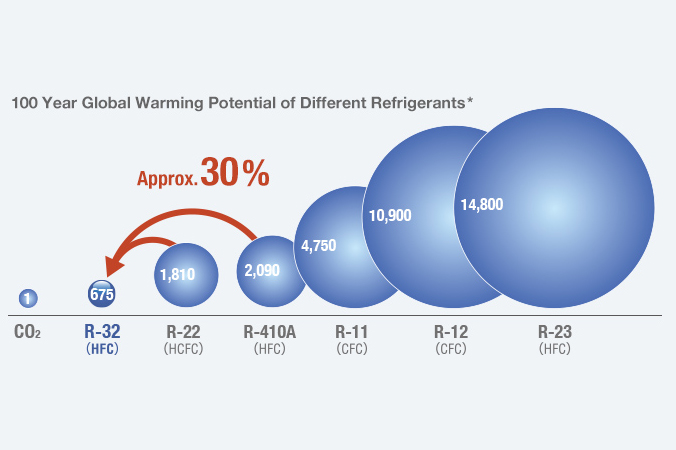We often hear about new initiatives, plans, proposals, and laws put in place to ensure that businesses are running as ecologically friendly as possible, and the HVAC industry is no exception. In fact, as the HVAC industry becomes more prevalent and necessary globally as the years pass us by, and global temperature continue to fall to extremes, the introduction of these initiatives and their importance only increases.
There are many initiatives proposed and already in action around the globe, put in place to reduce the impact of HVAC systems on the environment. A large part of the overall solution is finding ways to adopt more environmentally friendly refrigerants.

In the case of R32, a HFC refrigerant, there is an opportunity to not only reduce environmental impact but also improve operation and efficiency for the owner. A win/win for the environment and for business owners.
In this AirReps blog article, we will discuss the advantages of R32 compared to its predecessor R410A and its competitor R454B.
R-32 Refrigerant
R-32 equipment is widely available and well-tested. According to Daikin, across the globe there are currently over 200 million units already installed and operating, with installations dating back to more than a decade.
In addition, R-32 is non-proprietary and is produced by multiple suppliers, both in pure form and as a component of many blended refrigerants, which helps to ease any availability concerns.
Unlike R410A, the predecessor to R-32, or R454B, the current competitor to R-32, R-32 is pure. It’s a single molecule, not a blend of multiple refrigerants. This is important because it helps to improve system service ability by making reclaiming and reusing it easier than blended refrigerants. Additionally, it can be topped-off in either liquid or gas form.
Environmental Impact of R-32 Refrigerant
Part of the reason many worry about the environmental impact of refrigerants is from the unintended release of refrigerant into the atmosphere. The climate impact of released refrigerant is measured by its Global Warming Potential (GWP). R410A, the predecessor to this newer refrigerant, for example, has a GWP over 2,000. In the United States the CARB and EPA have established guidelines phasing out refrigerants with a GWP over 750. R-32 meets the new standards in the US and in many markets globally, making it a much-needed option.
In having a significantly lower GWP than R410A, it benefits the user and the environment. According to a study conducted in 2012 entitled “R-32 Compressor for Air Conditioning and Refrigeration Applications in China,” R32 typically consumes approximately 10% less energy for the same amount of cooling. This is important for the environment and for business owners, as this means reducing power bills and lowering emissions from related power generation. In addition, R-32 is also highly effective in heat pump applications, aiding efforts to electrify and de-carbonize.
Conclusion
R-32 refrigerant has emerged as a strong alternative to older products such as R410A due to its availability, energy efficiency, and lower environmental impact. Looking to make the switch, or wondering what the best HVAC solution is for your building or
brand? Connect with our AirReps Account Executives today, or reach out at [email protected] for all the latest on how R-32 Refrigerant can make a difference in your custom HVAC solution!
